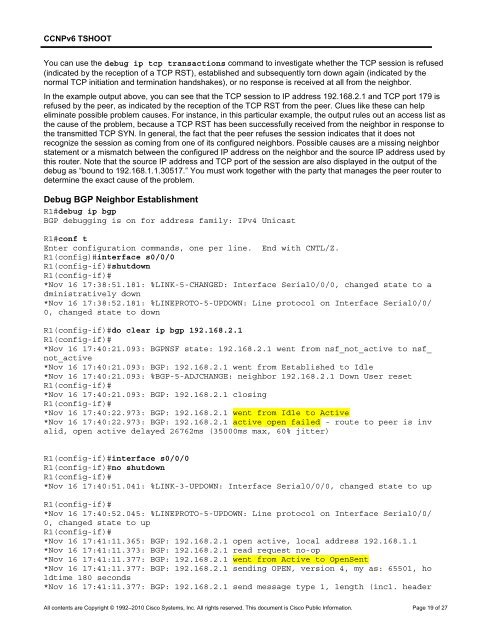CCNP TSHOOT 6.0 - The Cisco Learning Network
CCNP TSHOOT 6.0 - The Cisco Learning Network
CCNP TSHOOT 6.0 - The Cisco Learning Network
You also want an ePaper? Increase the reach of your titles
YUMPU automatically turns print PDFs into web optimized ePapers that Google loves.
<strong>CCNP</strong>v6 <strong>TSHOOT</strong><br />
You can use the debug ip tcp transactions command to investigate whether the TCP session is refused<br />
(indicated by the reception of a TCP RST), established and subsequently torn down again (indicated by the<br />
normal TCP initiation and termination handshakes), or no response is received at all from the neighbor.<br />
In the example output above, you can see that the TCP session to IP address 192.168.2.1 and TCP port 179 is<br />
refused by the peer, as indicated by the reception of the TCP RST from the peer. Clues like these can help<br />
eliminate possible problem causes. For instance, in this particular example, the output rules out an access list as<br />
the cause of the problem, because a TCP RST has been successfully received from the neighbor in response to<br />
the transmitted TCP SYN. In general, the fact that the peer refuses the session indicates that it does not<br />
recognize the session as coming from one of its configured neighbors. Possible causes are a missing neighbor<br />
statement or a mismatch between the configured IP address on the neighbor and the source IP address used by<br />
this router. Note that the source IP address and TCP port of the session are also displayed in the output of the<br />
debug as “bound to 192.168.1.1.30517.” You must work together with the party that manages the peer router to<br />
determine the exact cause of the problem.<br />
Debug BGP Neighbor Establishment<br />
R1#debug ip bgp<br />
BGP debugging is on for address family: IPv4 Unicast<br />
R1#conf t<br />
Enter configuration commands, one per line. End with CNTL/Z.<br />
R1(config)#interface s0/0/0<br />
R1(config-if)#shutdown<br />
R1(config-if)#<br />
*Nov 16 17:38:51.181: %LINK-5-CHANGED: Interface Serial0/0/0, changed state to a<br />
dministratively down<br />
*Nov 16 17:38:52.181: %LINEPROTO-5-UPDOWN: Line protocol on Interface Serial0/0/<br />
0, changed state to down<br />
R1(config-if)#do clear ip bgp 192.168.2.1<br />
R1(config-if)#<br />
*Nov 16 17:40:21.093: BGPNSF state: 192.168.2.1 went from nsf_not_active to nsf_<br />
not_active<br />
*Nov 16 17:40:21.093: BGP: 192.168.2.1 went from Established to Idle<br />
*Nov 16 17:40:21.093: %BGP-5-ADJCHANGE: neighbor 192.168.2.1 Down User reset<br />
R1(config-if)#<br />
*Nov 16 17:40:21.093: BGP: 192.168.2.1 closing<br />
R1(config-if)#<br />
*Nov 16 17:40:22.973: BGP: 192.168.2.1 went from Idle to Active<br />
*Nov 16 17:40:22.973: BGP: 192.168.2.1 active open failed - route to peer is inv<br />
alid, open active delayed 26762ms (35000ms max, 60% jitter)<br />
R1(config-if)#interface s0/0/0<br />
R1(config-if)#no shutdown<br />
R1(config-if)#<br />
*Nov 16 17:40:51.041: %LINK-3-UPDOWN: Interface Serial0/0/0, changed state to up<br />
R1(config-if)#<br />
*Nov 16 17:40:52.045: %LINEPROTO-5-UPDOWN: Line protocol on Interface Serial0/0/<br />
0, changed state to up<br />
R1(config-if)#<br />
*Nov 16 17:41:11.365: BGP: 192.168.2.1 open active, local address 192.168.1.1<br />
*Nov 16 17:41:11.373: BGP: 192.168.2.1 read request no-op<br />
*Nov 16 17:41:11.377: BGP: 192.168.2.1 went from Active to OpenSent<br />
*Nov 16 17:41:11.377: BGP: 192.168.2.1 sending OPEN, version 4, my as: 65501, ho<br />
ldtime 180 seconds<br />
*Nov 16 17:41:11.377: BGP: 192.168.2.1 send message type 1, length (incl. header<br />
All contents are Copyright © 1992–2010 <strong>Cisco</strong> Systems, Inc. All rights reserved. This document is <strong>Cisco</strong> Public Information. Page 19 of 27

















